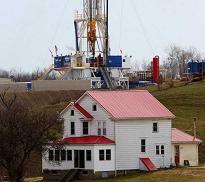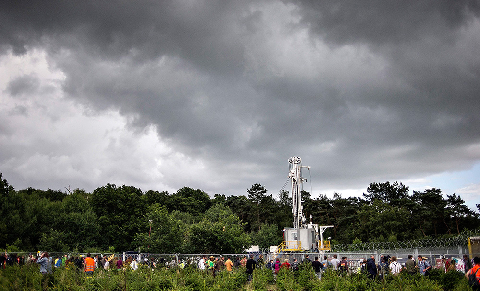The Mother of All Unfunded Mandates
June 24, 2013Ecological Theologian Reviews Gasland 2
June 29, 2013By Alison Grant, The Plain Dealer, June 18, 2013
 An earthquake that shook Youngstown on New Years Eve in 2011 was considered a rare occurrence, even as it raised concerns about seismic activity linked to the injection wells used to store waste water generated during hydraulic fracturing of shale.
An earthquake that shook Youngstown on New Years Eve in 2011 was considered a rare occurrence, even as it raised concerns about seismic activity linked to the injection wells used to store waste water generated during hydraulic fracturing of shale.
Tuesday, a scientist at a Cleveland conference on Utica shale gas development in Ohio said seismic activity with hydraulic fracturing is actually very common. The conference was hosted by Case Western Reserve University, and co-sponsored by Cleveland State University and Kent State University.
Forcing fluids underground — either while hydraulic fracturing of shale rock to release gas and oil, or when shooting waste water into injection wells — routinely produces “micro-seismic events” said Mark Zoback, professor of earth science and geophysics at Stanford University.
It’s important to note, Zoback said, that miniature earthquakes occur anyway, nearly everywhere there are fault zones in the earth’s tectonic plates. What pushing fluids underground can do is hasten what would have happened 1,000 years, 10,000 years or more in the future, he said.
“So is it something to worry about?” Zoback said to an audience of engineers, scientists, students and community activists gathered at Severance Hall for the conference on opportunities and challenges presented by shale gas for our region. “The answer is yes.”
Make no mistake: Zoback is a proponent of harvesting gas and oil from the country’s shale deposits, saying it offers the United States an opportunity for greater energy independence. But he said scientists and drillers need to get better at predicting and managing seismic activity triggered by shale gas development.
There are now about 150,000 injection wells in the country, technically known as Class II underground injection wells. In some of them, Zoback cautioned, “we started injecting more water than the (geologic) formations can accept.”
Day 2 of the two-day conference, sponsored by the National Academy of Engineering and hosted by Case Western, is from 8 a.m. to 12:30 p.m. Wednesday. Registration for the free event opens at 7 a.m. in the front lobby of Severance Hall.
Ohio Lt. Gov. Mary Taylor, in opening remarks Tuesday, said shale holds the promise of creating thousands of jobs; spurring restaurant, hotel and home construction; and sparking industry-related manufacturing and ancillary support businesses. She said Ohio colleges and universities are offering shale industry-related training so the state will have a prepared workforce when the still-young Utica shale play gets into full swing.
The Ohio Department of Natural Resources reported that a total of 358 Utica wells have been drilled since December 2009; 102 wells of those wells are in production. Carroll County is first in permits in Ohio with 288, an increase of 17 since the department’s update on June 1. Harrison County is second with 106 permits and Columbiana County is third with 73.
Jeanne Briskin, who coordinates hydraulic fracturing research for the U.S. Environmental Protection Agency, described work underway to look at its potential impact on drinking water.
Among the questions being examined by the EPA are:
— How might large-volume water withdrawals from ground and surface water — for use in the drilling process — affect drinking water?
— What are the possible consequences for drinking water of inadequate treatment of fracking waste water?
The EPA now has well records on over 12,000 wells entered into a data base called FracFocus. It has a “spill database” with information on accidents and leaks from operations in Colorado, New Mexico and Pennsylvania.
The agency also collected exhaustive information from nine major shale developers — who were granted confidentiality to encourage them to report thoroughly — on what chemicals they used in hydraulic fracturing. The tally: Over 1,000 unique chemical substances identified.
During a question and answer session, Zoback responded to a query about how best to protect aquifers, underground permeable rock formations that hold and transmit water.
“The answer is well construction, well construction, well construction,” Zoback said. “We know that wells are not being constructed as well as they should be, and we need to correct that.”



